Topics: Search Engine Optimization (Seo) Content Marketing
How Long Does It Take for Inbound Marketing to Work? 4 Green Industry Examples
 Author: Chris Heiler
Author: Chris Heiler
 As a landscape contractor, have you ever been asked by a client, "How long will it take for my ground cover to fill in?", or, "How long will it take until my trees and shrubs mature?"
As a landscape contractor, have you ever been asked by a client, "How long will it take for my ground cover to fill in?", or, "How long will it take until my trees and shrubs mature?"
As a marketing agency, we're often asked a similar question: "How long will it take before this (inbound marketing) starts working?" As in landscaping and gardening, we like to use the sleep, creep, leap analogy when describing the natural progression of inbound marketing. The cliche, "It's a marathon, not a sprint", is also appropriate.
When discussing our services with a potential client, we're always candid about what can be expected. The reality is that launching an amazing new website, an insightful company blog or an engaging Facebook Page most likely will not impact your bottom line in the first few months.
Spending time and money without immediate payoff can be frustrating. We get that. But, it's just the reality of modern day marketing, and instead of focusing on short term spending, we encourage our clients to focus on building a strong foundation that will drive bottom line results over the long term in a sustainable way.
So, how long can it take to build that foundation I referred to? How long does it take to gain traction and momentum that can truly impact your company's bottom line?
Gaining momentum with your company blog
We're going to take a close look at blogging as it relates to building momentum because first, blogging is one of the most important elements of a comprehensive inbound marketing program, and second, measuring the growth and progress of a blog is fairly straightforward.
Starting a company blog can be very frustrating. Typically this is because a company doesn't start with their expectations in alignment with reality, which leads to abandoning the blog prematurely. The misguided expectation tends to unfold like this:
- We'll write and publish our awesome, one-of-a-kind insights as a blog post.
- People will read our wonderful blog post.
- Those same people will then buy our products and services.
Blogging just doesn't work like that, folks! According to the software company, MOZ, it takes an average of seven visits to their website before a visitor signs up for a free trial. Seven visits for a FREE trial!
Blogging takes patience. You don't build trust with a stranger with a single blog post. It can take multiple visits and views before you acquire the trust of your website visitors and earn their distinction as an authority or expert on a topic. It could be many months after the first touch — and many visits later — that a prospect decides to fill out a contact form or pick up the phone and call you.
My point should be clear: Don't give up prematurely when your writing appears to be falling on deaf ears. You've got to keep pushing until you get traction.
How long can that take? Let's take a look at two real world examples, the first being this blog you're reading right now.
The graph below shows the number of views of Landscape Leadership's blog posts over the last eight quarters (24 months total). I feel like we hit our stride after 12 months of consistent blogging, nearly doubling our views from 3,363 to 6,023 per quarter. As you can see from the graph, the number of blog post views exploded from there. (Note: In this time period we published 95 unique blog posts, about four posts per month.)
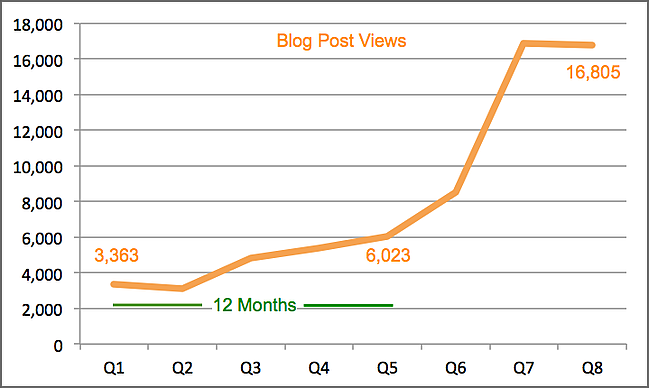
The second example — a commercial landscape maintenance contractor — is a client of Landscape Leadership. In the graph below you can see that this client went from zero blog post views upon launching their blog to approximately 1,500-1,700 views per quarter after about 13 to 14 months. This was the point at which we felt we had gained really positive momentum with their company blog. (Note: 105 unique blog posts were published during this time period, about five posts per month.)
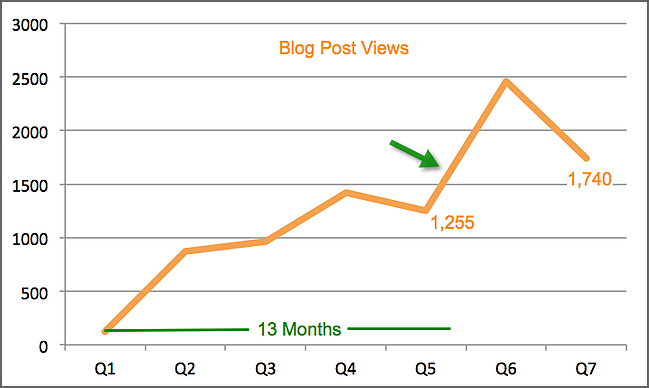
It takes many months of consistent effort to be rewarded by the search engines like Google and Bing in the form of organic search traffic. As you create more and more content — much of it optimized for very specific keyword phrases — you're rewarded with higher rankings in the search engine results pages (SERPs). The more helpful content you create the more people who will find it when searching for information related to your subject.
While it took these two blogs 12 to 14 months to get traction, you can seize momentum faster by publishing high quality content more often. Publishing two to three blog posts per week, as opposed to one per week, will absolutely speed up this process. Of course this requires more resources: both time and money.
Momentum from organic search traffic: more visitors and more leads
Another positive indicator of inbound marketing momentum is the steady growth in the number of website visitors and new leads from organic search month over month.
Organic search traffic refers to those visitors who found your website via an online search engine like Google. Perhaps they searched for the phrase "landscapers pensacola fl" on Google and found your website ranked in the top position on the results page. This traffic from organic search is crucial to your online and overall business success because these are the folks who are probably not familiar with your business yet they're looking for your products and services to fill a current need. You want them to find you, not your competitor.
Many of the green industry websites we look at have stagnant or highly fluctuating traffic (based on the season) from organic search. You want steady growth month after month and year over year which translates into more and more prospects — who aren't familiar with your company — finding you on a regular basis.
Let's look at a real world example, a green industry contractor we began working with in October of 2013. From March 2013, seven months prior to our engagement, through February 2014 this contractor hovered around 300 visits per month from organic search over these twelve months. This is what I mean by stagnant. There was no growth or momentum whatsoever. The screenshot below shows the stagnant traffic growth from October 2013 to February 2014.
You can see in March 2014 this contractor's website began to gain traction, ultimately more than doubling their monthly organic search traffic by June and July of 2014. After six months into our engagment with this contractor I felt like we were beginning to seize positive momentum.
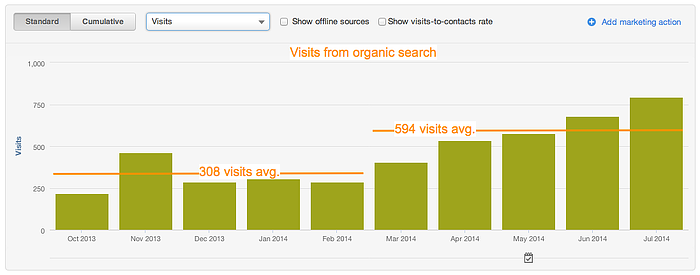
We were also showing tremendous momentum as it relates to lead generation from the organic search traffic. Increasing traffic to your site is one thing, actually turning those visitors into qualified leads is another. This is where you start to see the payoff in your inbound marketing investment.
Looking at the screenshot below you can see that this contractor's website was not generating any new leads when we began working together in October 2013. It wasn't until March of 2014 — six months later — that their site began capturing their first new leads. It was about seven months until they seized momentum from a lead generation standpoint, almost mirroring the timing and traction they gained from a traffic perspective.
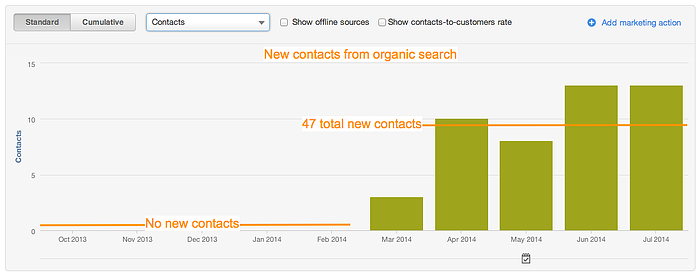
Illustrating momentum like this is not always enough in the eyes of a client, and unfortunately, this is a perfect example of that. We're no longer working with this particular client because they "don't believe inbound marketing works". They're throwing in the towel just as they have seized momentum.
Now let's look at a company — a full-service landscape contractor — that can serve as a model for building momentum and how that impacts the bottom line.
From the screenshot below you can see this contractor was hovering between 1,000 and 1,500 visits per month from organic search between March 2013 and July 2013. They started to get traction six to seven months in, finally reaching 2,000 visits per month in September. From that point it was a quick climb to 3,000 visits per month and then to over 4,000 visits per month from organic search in July of 2014. You can see the momentum over the past five months has been tremendous.
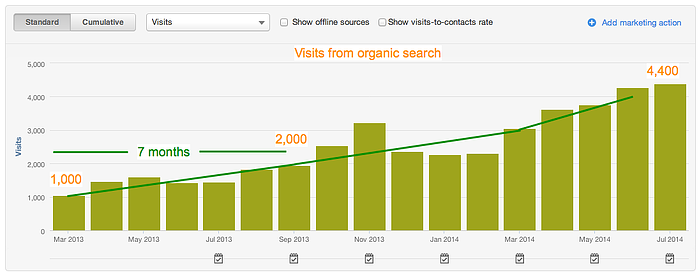
The screenshot below shows similar momentum over the same time period only for total number of new contacts each month. Over the past three months this contractor, on average, has generated 35 new contacts from organic search traffic. That's over 100 new leads for their sames team compared to a total of 28 leads from the same time period in 2013. This contractor has momentum now and sure as heck isn't going to let up on the gas, especially as many of these new contacts turn into real opportunities and closed sales.
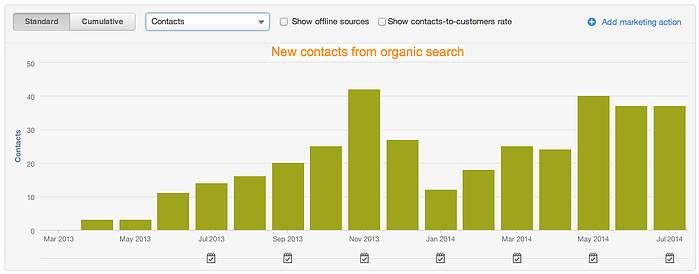
Wrap up
As I said in the intro, inbound marketing should be treated as a marathon, not a sprint. From these examples you should be able to see the sustainable, snowball effect inbound marketing can have, not just on the number of website visitors, but on your bottom line as measured in new leads and new sales. That said, it clearly takes patience. Often six months is needed to get real traction with your biggest gains coming 12 months into the program.
The beauty in the inbound marketing approach is that your effort and inputs — even in the very early stages — build on each other in almost an exponential way. This is very different from direct mail and traditional advertising that many of you in the landscape and lawn care industry are accustomed to.
I hope you found this article to be helpful. This question of "momentum" is one we're asked often! If you want more marketing and sales insights be sure to subscribe to our blog. Do it here! If you have any questions or comments feel free to leave them below. Or you can always fill out our handy contact form or hit us up the old fashioned way: (800) 681-9169.
Image credit (top): Joi Ito




